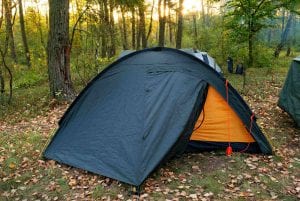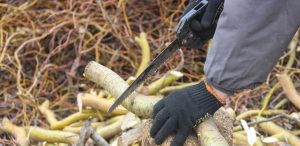
There’s nothing quite like a day spent out in the cold to make you relish a bit of warmth at the end of it. Unfortunately, that’s not always the reality of winter camping. As you sit there with a thin layer of fabric between you and the cold air, breath steaming, fourteen hours of darkness ahead, the thought comes to you:
“I wish I could get a heater for this frozen canvas coffin.”
When it comes to how to heat a tent without electricity, misinformation is rife. Sift through the Internet and you’ll find staggering quantities of BS on the subject, all presumably cranked out by armchair adventurers who’ve never set foot near a tent.
But you genuinely can get that cold tent cozy, and here’s how…
- Put simply, the best way to heat a tent without electricity is to use a vented wood stove in a tent that’s designed for it.
- Propane heaters can also work, but they’re heavy and expensive to run.
- Used wrongly, both wood and propane heaters can be deadly, so it’s important to follow strict safety rules.
- But do you need to heat the tent at all? It’s usually much easier to heat yourself.
Safety First
In some ways, tents and heaters are a match made in heaven, but in other ways they’re absolutely not.
It’s impossible to stress too much that a tent heater can kill you if you’re not careful, so before we go any further, there are some warnings to get out of the way.
Carbon Monoxide Poisoning
There’s a reason they call carbon monoxide “the silent killer,” and every winter brings tragic news stories of people in motorhomes, boats, or cabins who fall asleep and never wake up.
Carbon monoxide gas (CO) is produced when carbon-based fuels like wood, gasoline, or oil don’t burn properly due to insufficient oxygen. This is more common in confined, poorly ventilated spaces — including tents.
The lack of ventilation causes two problems: it increases the amount of CO that’s produced, and it also allows it to build up to dangerous levels.
Carbon monoxide stops your red blood cells being able to carry oxygen around your body. Symptoms of low-level exposure can include headaches, dizziness, and nausea, while higher levels of CO can kill you within hours.
You can’t see, smell, or taste carbon monoxide, and if you’re asleep when the gas builds up then you won’t be able to notice the warning signs.
Both wood and propane stoves emit carbon monoxide, and for this reason, there are some absolute red-line safety rules if you’re using portable heaters to generate heat:
- Make sure the area is well ventilated
- Bring a good carbon monoxide detector
- Don’t leave the stove on when you go to bed
Burns
Wood stoves in particular can get blisteringly hot. Remember to pack heat-proof gloves, fire tools, and a first aid kit.
A common burn injury in teepees or bell tents happens when people rest their hand absent-mindedly on the vertical stove pipe as they walk around it.
It’s instinctive and you do it with the central tent pole all the time, of course, but the difference is that the flue is hot enough to fry an egg.
Damage to Your Tent and Equipment
Stoves designed for tent use should incorporate various safety features. Wood-burners will usually have a sort of sleeve to protect the tent fabric from the hot flue, while any decent propane heater will shut off automatically if it gets knocked over.
Likewise, tents should feature some adaptations, including heat-proofing around the hole where the stovepipe exits. The floor of a tent that’s been designed to take a stove should have some level of heat resistance, or may have a cut-out section where the heater goes.
Having said that, a heat mat is neither expensive nor heavy in the context of a stove system, so it’s worth investing in a nice big one to give your tent floor an extra layer of protection.
Fire Risk
In the case of wood stoves, it goes without saying that you should never start a fire that you can’t put out. Always have the means to kill your fire, whether that’s a portable extinguisher or just a large container of water.
One fire that you definitely won’t be able to put out is a forest fire. Though most stoves will feature spark arrestors over the end of the chimney, these aren’t 100% effective, so it’s much safer not to light your stove at all in high fire-risk areas.
Stoves
The pioneers of old didn’t unload their wagons, pitch their great big canvas tents then start scratching around for the nearest hook-up for their electric heater. They used wood-burning stoves to stay warm.
Fast-forward a couple hundred years and a woodburner is still the best way to heat a tent without electricity. These days, though, they mostly pack down to the size of a gym bag. And — with some specialist models weighing as little as 15oz — they’re even a viable option for backpackers.
Suggestions
- Check out the OneTigris “Tiger Roar” tent stove >>
Larger “Hot Tents”
There are plenty of tents available that are specifically designed to take a wood-burning stove. Larger models tend to be old-fashioned bell tents or teepees, often with a real Klondike-Gold-Rush vibe.
They’re usually made in tough canvas or polycotton, and sometimes have spark-resistant groundsheets. The really important features for a hot tent are a heat-resistant outlet for the stove pipe (preferably one you can seal up when it’s not in use) and plenty of ventilation to keep carbon monoxide levels down.
These roomy set-ups offer the ultimate in winter camping comfort, though they’re often so heavy that you’ll need a truck or snowmobile to haul them.
Suggestions
- OneTigris “Tegimen” is a large hot tent (12′ x 6′ x 6′) designed for hanging a hammock inside. You can pick it up at a very reasonable price from Amazon >>
- Ozark Trail also do a decent hot tent. The “North Fork” is 12′ x 10′ and can sleep 6. It’s available for about $400 from Walmart >>
- If you want to go all out on a base camp rig (perfect for hunting), then the “Ultimate Alaknak” (10′ x 10′) from Cabelas is worth checking out >>
Backpacker Hot Tents
Hot-tenting isn’t just for car campers. With a foldable titanium or aluminum stove and a lightweight tent, you can get your weight down to 8 pounds or even less, which is doable for a backpacker.
Of course you’ll also need to bring a hatchet, knife, folding saw, and tinder, but outdoor adventures in winter are never going to be a featherweight game.
It’s a fact of life that you need a lot more gear to travel safely in cold weather. And once the snow’s on the ground, you can use a pulk or snow sled to haul heavier loads much more easily.
Adapted Hot Tents
DIY outdoorsmen can fine-tune their hot-tenting setup by adapting a tent of their choice to take a stove. They might do this to save money or weight, or simply because there isn’t anything on the market that fits their preferences.
Adapting a warm tent does take a fair amount of skill and consideration, though. The stove needs to sit well clear of both the tent wall and the occupant, you’ll have to pick a tent with plenty of ventilation, and there’s also the matter of making an opening for the stove pipe.
Then, once you’ve got over the gut-twisting feeling of cutting a hole in a $400 tent, you’ll need a piece of fire-resistant material to separate the flue from the tent fabric. These are available pre-made for certain stoves or tents (and are sometimes called “stove jacks”), but you can also make one yourself.
In general, it’s best to do a deep dive into the DIY forums before you go down this route.
Sourcing Fuel Responsibly
For the avoidance of doubt, you can’t just rock up at a campground, fire up the chainsaw, and start buzzing someone else’s trees into firewood.
If you’re camping with a vehicle, the easiest way to keep that stove roaring away until bedtime is to bring sacks of wood with you. Just remember that transporting firewood long distances can be both harmful and illegal, so check the regs and either buy it locally or use certified heat-treated wood.
Clearly, packing your firewood isn’t really an option if you’re hiking, but it’s still important not to cut down or damage living trees. Apart from anything else, green wood won’t kick out much heat anyway.
Leave yourself plenty of daylight to gather dead wood at the end of the day, and consider keeping some back each night so that you’ve got a few dry sticks of kindling to get things started the following evening.
Fortunately, camp stoves are so efficient that you won’t need too much fuel to take the chill off a small tent.
Propane Heaters
If you’re not comfortable with wood stoves for whatever reason — or if you’re camping somewhere that doesn’t allow them — you can use a propane heater to heat a tent without electricity.
Though they can work well for car camping, these heaters are usually too heavy to be useful for backpacking, particularly since they use bottled propane that you’ll need to bring with you.
It’s super-important that any portable heater you use in a tent is specifically designed for indoor use. Many gas heaters — especially the lamp-style ones — are meant to keep you warm when you’re sitting out in the open air, and both their heat and carbon monoxide output will make them very dangerous under canvas.
Check out Mr Heater “Little Buddy” >>
Ceramic Heaters
Most propane powered heaters use a blue flame to heat a ceramic tile. Any decent one will include a tip-over cut-out switch and an oxygen sensor that automatically shuts it off if the O2 level drops too low.
While these are essential safety devices, the oxygen sensors mean that they often won’t operate at altitude where the air is too thin.
This sort of camping heater is popular with the RV posse, and some models are reasonably safe to use within a larger tent, subject to the safety rules listed above. You’ll need to be very diligent about ventilation, and — as with all heaters — you should never leave it on when you go to bed. It’s tempting in chilly temperatures, but it’s just not worth it.
Catalytic Heaters
A catalytic heater produces heat through a catalytic reaction, so there’s no open flame. They’re the safest and most fuel efficient heaters for camping, but they’re also expensive and difficult to find.
If you’re searching online for a catalytic heater, make sure that the one you’ve found doesn’t mention “ignition” or similar terms. If it does, then it’s just a standard radiant heater rather than a catalytic.
Estimating Fuel
A huge downside with propane heaters is the sheer amount of gas you’ll go through.
Though it varies by brand and design, your average gas heater will genie a standard-size cartridge in an hour and a half, so you’ll need a truckload to see you through a cold-weather camping trip.
Insulating Your Tent
However you heat your tent, keeping the warmth inside the tent walls is likely to be a challenge.
By its nature, a tent is never going to be particularly well insulated. However, some models are definitely better than others, and there are things you can do to try and improve your tent’s insulating qualities — both from the ground and the cold air.
Ground Insulation
In winter, putting a layer of insulation between yourself and the cold ground can make a whole lot of difference. This might be as simple as using a thicker groundsheet, or car campers may choose to bring rolls of insulated matting.
If you’re hiking and weight is at a premium, you could look to upgrade your sleeping pad to one with a higher R-value.
Wall Insulation
In most cases, wall insulation in tents is achieved through a double-wall construction. Winter tents with an outer fly and a separate inner one create a layer of warm air, and they also suffer much less from condensation — meaning that you don’t need to leave vents open in cold weather.
Some articles recommend sticking those reflective space blankets from your first aid kit all over the inside of your tent to improvise an insulated tent. The effort and frustration of trying to achieve this might just warm you up a bit on cold nights, but that’s about all that will.
Mylar blankets will be much more effective if you wrap them around yourself to maintain your body temperature. In fact, that brings us to one of the key elements of keeping warm in a tent…
Heating Yourself Rather Than the Tent
Do you really need to heat the tent at all? If you’re going to be sitting around talking, playing games, drying wet gear, or whatever else, then the answer might be yes.
In many cases, though, it might be a lot easier just to warm yourself up rather than the entire tent. After all, your body will store heat better than any portable heat source. Here are a few tips.
Hot Water Bottles
An old-time favorite on cold nights in the great outdoors. You can use a plastic bottle, but make sure it’s one that’s rated to take hot liquids.
Seal it up good and tight, and never use boiling water. Some luxury-loving campers like to preheat their sleeping bag by slipping the hot water bottle in there twenty minutes before they crawl in.
A Good Sleep Set-up
Genuinely, this will make more difference than everything else in this article combined. Sleep on a well-insulated sleeping pad, in a sleeping bag that’s warm enough for the conditions, and there’ll be no need to heat your tent at all.
Of course, pads and sleeping bags aren’t the only options — you might be more of a cot camper or enjoy big cozy quilts — but the principle is the same whatever set-up you use. Insulate yourself really well and you’ll sleep warm on the coldest of nights.
Eating and Drinking Well
When the temperature drops, you’ll find you need to put away a whole lot more calories for a good night’s sleep. Keep well-fed and hydrated (preferably with warming packet soups and hot drinks) and your own internal heater will be firing on all cylinders.
Wearing Warm Clothes in Bed
A divisive subject among campers, but most will wear some sort of long underwear to sleep in during freezing weather. Merino wool is a popular choice — being warm, breathable, and itch-free.
It can also be worth packing a few socks, gloves, and a woolly beanie to keep your head warm.
If you’re prone to a cold nose in the night, consider using a fleece tube or neck gaiter over your nose and mouth — rather than putting your face inside your sleeping bag and getting it damp with condensation from your breath.
Using Someone Else’s Body Heat
Nothing says romance like using your beloved as a hot water bottle. If you’re camping as a couple, it’s definitely worth using a double sleeping bag to share body heat during a cold night — and it can also be a good test of your relationship.
When one partner gets up for a bathroom trip in the night and slides back into the sleeping bag imitating a human popsicle, only the truest of partners will allow them anywhere near until they’ve warmed up.
If you’re not yet ready to inflict your ice-block feet on a new squeeze, consider the safer option of man’s best friend. A good hiking dog will relish the chance to cuddle up to you on winter nights, however cold you are — though getting the smell of wet canine out of your sleeping bag when you return home can be a challenge.
How To Heat a Tent Without Electricity (NEVER DO THESE THINGS!)
Camping gear websites are full of bizarre, ineffective, and sometimes eye-poppingly unsafe ways to heat a tent, amplified by the echo-chamber of search algorithms.
Here are some of the most common “heating hacks.”
Using a Candle Heater
Candle lanterns give out a lovely warm light, and the idea is that the heat from a few flickering flames will somehow spread a rich glow of heat throughout your tent, raising the temperature inside.
At best, this is stretching the laws of physics, and at worst it’s encouraging people to go to sleep in a bag full of very flammable feathers with a lit candle next to them.
Heating Rocks
Everyone’s heard this one. You fetch a load of round cobblestones and place them round a nearby campfire until they get really hot. Then, you retrieve each heated rock without burning yourself, wrap them in the non-synthetic cloths that you’ve brought from home for this very purpose, and place those hot rocks on the floor of your cold tent.
With any luck, these heated rocks might just be briefly hot enough to melt your polyester groundsheet before they quickly go cold.
Some articles even recommend fetching nice smooth stones from the river, presumably because waterlogged rocks stand the best chance of cracking or exploding as you heat them up.
Pitching Your Tent Over a Campfire
Our personal favourite, guaranteed not to go wrong! You dig a trench, light a fire in it and get it really hot, then you fill in the fire pit and pitch your tent over the top of the hot coals.
This is a time-honored technique for roasting meat, and if you get it slightly wrong then it may also prove a good way to roast yourself alive.
FAQs
Can I Keep My Tent Warm Without Electricity?
To heat a tent without electricity, you can use either wood stoves or propane heaters. Though it’s important to take safety precautions against fire and carbon monoxide poisoning.
Is There a Safe Way to Heat a Tent?
With care, electric heaters, wood stoves, and propane heaters can all be safe ways to heat a tent.
It’s important to use models that are specially designed for this purpose, and to take safety precautions like ventilating the area, using a carbon monoxide detector, and making sure the heater is out before you go to bed.
How Do You Heat a Camping Tent?
You can heat a tent safely by using an electric, propane, or wood-fired tent heater, though it’s important to take precautions. However, it’s usually easier just to warm yourself up rather than warm the whole tent. Bring hot water bottles and winter sleeping bags!
Do Battery-Powered Tent Heaters Exist?
Unfortunately, the amount of power you need to heat even just a small space means that battery-powered tent heaters aren’t available.






